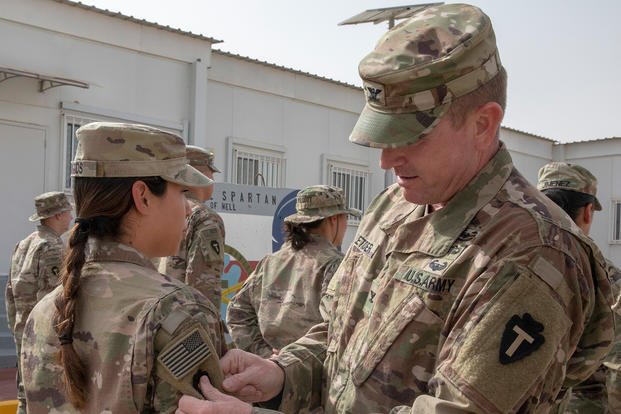The Army has expanded eligibility for earning combat patches to soldiers deployed across 14 countries in the Middle East and Africa, a shift that comes as attacks from Iran and its sanctioned militias have hit bases far from active fighting.
The policy shift, issued last week, covers soldiers who served in Bahrain, Egypt, Iraq, Israel, Jordan, Kuwait, Lebanon, Djibouti, Pakistan, Qatar, Saudi Arabia, Syria, the United Arab Emirates, and Yemen between Oct. 7, 2023 — the date of Hamas’ surprise attack on Israel — and June 24, when the U.S. launched an airstrike on an Iranian nuclear facility.
“These changes acknowledge the inherent risks and challenges faced by soldiers in these locations and timeframes,” the Army said in a news release. “Awarding the combat patch reflects the Army’s commitment to recognizing the contributions and sacrifices of all soldiers serving in these operational environments.”
Read Next: Plans for Mass VA Firings Scuttled, But Department Still Expects 30,000 Employees to Leave on Their Own
It’s unclear why the Army set an end date of June 24 for the policy, given that many of the threats to U.S. forces in the region, including drone and rocket attacks, remain ongoing.
It’s also unclear how long Army planners have been pushing to expand combat patch eligibility. The change comes a year after an internal draft memo surfaced online, authorizing the patches for troops. That document, which also backdated eligibility to Oct. 7, 2023, never went into effect.
In it, Lt. Gen. Douglas Stitt, who was the top personnel policy officer at the time, signed the memo, noting he approved an “exception to policy” waiving the requirement to pay bonuses for serving in combat zones to be a prerequisite for patches.
The updated policy waives the traditional requirement for those patches to coincide with extra pay and benefits. Historically, soldiers serving in environments where they are eligible for combat patches often receive pay bonuses associated with serving in a hostile environment. There is also no time-in-theater requirement, compared to a past requisite that soldiers serve in a combat zone for a month to earn their patches.
It’s also unclear how the countries were selected. Locations such as Egypt and Kuwait are considered peaceful deployments with minimal risk for most troops. The eligibility omits Somalia, which has been the site of sporadic combat since the 1990s.
Combat patches are worn on a soldier’s right sleeve and serve as an indicator of the unit they deployed to a war zone with. Those patches, which were commonplace in the 2000s and early 2010s, have become relatively rare in the low-to-mid ranks as the post-9/11 wars have largely wound down and the service has turned its focus to the Pacific, aiming to counter Beijing’s growing influence.
Soldiers without those patches are sometimes referred to as “slick sleeve,” a derogatory term, sometimes made in gest, to refer to troops who have not served in combat.
Related: New Army Shaving Policy Will Allow Soldiers with Skin Condition that Affects Mostly Black Men to Be Kicked Out
Story Continues
Read the full article here

